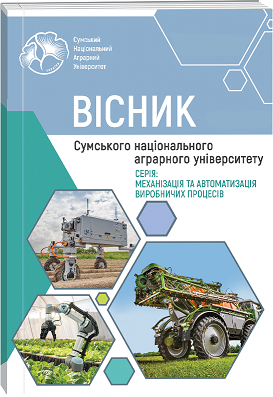ДОСЛІДЖЕННЯ ЩІЛЬНОСТІ ГРАНУЛОМЕТРИЧНИХ СКЛАДОВИХ ҐРУНТУ ЗА МАГНІТНИХ ВЛАСТИВОСТЕЙ
Анотація
The article presents the results of theoretical and experimental studies to determine the magnetic susceptibility of soil and its particle size distribution components by the induction method. According to its physicochemical composition, the soil an be classified as a composite material of diamagnets and paramagnets with a granulometric composition of sand and clay in the appropriate proportions, which are significant in the flow determination of soil density. Research objective: Improvement of the flow non-destructive determination of soil density in the technological chain "Compositional composition – magnetic susceptibility in a cyclic magnetic field – density of the main types of soils". Research methods: Analytical studies of the principles of interaction of the magnetic field with dia- and paramagnets. Experimental studies of the interaction of soil samples and its particle size distribution components with an alternating magnetic field. Analysis of experimentally obtained characteristics within the ranges of interactions of the particle size distribution of the soil with the magnetic field. Research results: Dependencies of the interaction of magnetic susceptibility with the index of density and particle size distribution of soil were obtained. A regression analysis of the relationship between density and magnetic susceptibility under the cyclic interaction of the magnetic field was performed. The time of interaction of cyclic interaction is substantiated from the standpoint of constructing models of correlation of magnetic susceptibility indicators by particle size distribution components. Linear models of functional relationships of density and magnetic susceptibility indicators for the duration of the cyclic interaction range for granulometric compositions of the main soil types have been developed. The results of the research are promising for the development of means for the flow non-destructive study of agrophysical indicators of the soil.
Посилання
2. Bariakhtar V.G., Dovguj S.О. Bozhynova F.Y. Kiriukhina О.О. (2019). Fizika: Pidruchnyk dlia 11 klasu. [Physics: a textbook for the 11th grade]. Kharkiv: Ranok, 272 p. (in Ukrainian).
3. Bilecskyi V.S., (2004). Mala hyrnicha encyclopedia, v 3 t, Т1. [Small chemical encyclopedia, in 3 volumes, V1]. Donetsk: Donbas, 640 p. (in Ukrainian).
4. Dlouhá Š., Petrovský E., Kapička A., Borůvka L., Ash C., Drábek O. (2013). Investigation of polluted alluvial soils by magnetic susceptibility methods: a case study of the Litavka River. Soil and Water Research. 151, p 151-157, https://doi.org/10.17221/14/2013-SWR.
5. FarzadShirzaditabar and Richard J.Heck. (2022). Characterization of soil magnetic susceptibility, a review of fundamental concepts instrumentation and applications. Canadian Journal of Soil Science. 102(2), p. 231-251. https://doi.org/10.1139/cjss-2021-0040.
6. Freddy A., Diaz-Gonzalez, Jose Vuelvas, Carlos A. Correa, Victoria E. Vallejo, D. Patino. (2021). Machine learning and remote sensing techniques applied to estimate soil indicators Review. Ecological Indicators. http://doi.org/10.1015/j.ecolind.2021.108517.
7. Hanxiao X., Yingui C., Gubai L. (2022). Variability in reconstructed soil bulk density of a high moisture content soil, a study on feature identification and ground penetrating radar detection. Environ Earth Sci. 81. https://doi.org/10.1007/s12665-022-10365-1.
8. Hossain M. Shahadat, G. K., Mustafizur M Rahman, Solaiman A.R.M., Alam M. Saiful, Rahman M. Mizanur & M. A. Baset Mia (2020) Estimating Electrical Conductivity for Soil Salinity Monitoring Using Various Soil-Water Ratios Depending on Soil Texture. Communications in Soil Science and Plant Analysis. р 635-644. https://doi.org/10.1080/00103624.2020.1729378.
9. Hudzʹ V. P., Primak I.D., Budyonny Yu, V., Tanchik S.P. (2010). Zemlerobstvo: textbook [Agriculture: textbook]. Kyiv. Сentr uchbovoi literaturі, 464 p.
10. Ivaniuta, M., Dr, prof. Kravchuk V., & Ramus M. (2023). Forecast for the Adaptive Tillage System International Journal of Life Science and Agriculture Research. 2(7), р.193–199. https://doi.org/10.55677/ijlsar/V02I07Y2023-06.
11. Kamran Azizi, Shamsollah Ayoubi, José A.M. Demattê. (2023). Controlling factors in the variability of soil magnetic measures by machine learning and variable importance analysis. Journal of Applied Geophysics. https://doi.org/10.1016/j.jappgeo.2023.104944.
12. Kartashov S.G., Gorodetsky E.U., Dudka V.S., Moskaluk A.A. (2012) Vpliv optimalnoy schilnosty gruntu dla riznih silskogospodarskih kultur na vrogajnist. [The effect of optimal soil density for different agricultural crops on yield]. Taurian Scientific Bulletin. Series: Agricultural sciences. V. 78. P 21-26. (in Ukrainian).
13. Khilov V. S. (2018). Teoreticni zasady ektrotehniki. [Theoretical Fundamentals of Electrical Engineering]. Dnipro. 445 p. (in Ukrainian).
14. Kravchuk V., Ivaniuta M., Bratishko V., Gumeniuk Y., Kurka V. (2023) ON-STREAM SOIL DENSITY MEASURING, INMATEH, P. 665-672 https://doi.org/10.35633/inmateh-69-64.
15. Kravchuk V.I., Sinchenko V.M., Ivaniuta M.V., Shustik L.P. (2022). Potokove vyznachennia shchilnosti hruntu: stan i prohnoz doslidzhen. The latest technologies in the agroindustrial complex: research and management. [Current determination of soil density: research status and forecast]. v30(44). p 107-115. http://dx.doi.org/10.31473/2305-5987-2022-1-30(44)-11. (in Ukrainian).
16. Lawrence Que (2011). Physical methods in bioinorganic chemistry: spectroscopy and magnetism. University Science Books. p. 345–348.
17. Lundgren, Julia & Grémiaux, Alexandre & Eberhardt, Jacob. (2013). Theoretical study of the interaction between an ion-protein complex and an extremaly weak low-frequency combined magnetic field. https://doi.org/10.13140/2.1.5057.9524.
18. Mohamed, Abdel-Mohsen & Paleologos Evan (2018). Magnetic Properties of Soils. 10.1016/B978-0-12-804830-6.00015-6.
19. Morrish A. H. "The Physical Principles of Magnetism" John Wiley & Sons (1965). 273 p.
20. Müller K. H. (2001). Magnetic Viscosity. https://doi.org/10.1016/B0-08-043152-6/00869-X.
21. Jordanova N. (2017). Soil Magnetism Applications in Pedology. Environmental Science and Agriculture. Academic Press. 445 p.
22. Orchard A.F. (2003). Magnetochemistry. Oxford Chemistry Primers. Oxford University Press. ISBN 0-19-879278-6.
23. Rekveldt M. & Bouwman, Wim & Kraan, W.H. & Grigoriev, S.v & Uca, Okan & Keller, T. (2002). Overview of new Larmor precession techniques. Applied Physics. A 74, p 323-325. https://doi.org/10.1007/s003390101096.
24. Różański Adrian. (2022). Relating thermal conductivity of soil skeleton with soil texture by the concept of “local thermal conductivity fluctuation”. Journal of Rock Mechanics and Geotechnical Engineering. Volume 14, Issue 1, p 262-271, ISSN 1674-7755, https://doi.org/10.1016/j.jrmge.2021.06.008.
25. Ruh, A, Kiselev, VG. (2019). Calculation of Larmor precession frequency in magnetically heterogeneous media. Concepts Magn Reson. Part A. https://doi.org/10.1002/cmr.a.21472.
26. Saidati Bouhlassa, Naima Bouhsane, (2023). "Assessment of the impacts of land-use change and slope position on soil loss by magnetic susceptibility-based models". International Journal of Sediment Research. 38(3). https://doi.org/p.455. doi:10.1016/j.ijsrc.2022.11.006
27. Sashini Pathirana, Sébastien Lambot, Manokarajah Krishnapillai. (2023). "Ground-Penetrating Radar and Electromagnetic Induction. Challenges and Opportunities in Agriculture". Remote Sensing. 15(11). p. 2932. https://doi.org/10.3390/rs15112932.
28. Syrotuk V.D., Miroshnychenko Yu.B. (2019). Fizyka i astronomiia: Pidruchnyk dlia 11 klasu. [Physics and astronomy, a textbook for the 11th grade] Kyiv: Geneza. 368 p. (in Ukrainian).
29. Volodin M.O. (2002). Osnovy zemelʹnoho kadastru. Navchalʹnyy posibnyk. [Basics of land cadastre. Tutorial]. Kyiv: Instytut zmistu i metodiv navchannya MON Ukrayiny. 352 p. (in Ukrainian).
30. Yang, Y.; Shang, K.; Xiao, C.; Wang, C.; Tang, H. (2022). Spectral Index for Mapping Topsoil Organic Matter Content Based on ZY1-02D Satellite Hyperspectral Data in Jiangsu Province. China. ISPRS Int. J. Geo-Inf. 11. p. 111. https://doi.org/10.3390/ijgi11020111.
31. Zhang, X., Zhang, J., Li, L., Zhang, Y., Yang, G. (2017). Monitoring Citrus Soil Moisture and Nutrients Using an IoT Based System, Sensors. 17, p 447. http://doi.org/10.3390/s17030447.
32. Zhang, GL., Liu, F., Song, XD., Zhao, YG. (2016). Digital Soil Mapping Across Paradigms, Scales, and Boundaries: A Review. In: Zhang, GL., Brus, D., Liu, F., Song, XD., Lagacherie, P. (eds) Digital Soil Mapping Across Paradigms, Scales and Boundaries. Springer Environmental Science and Engineering. Springer, Singapore. https://doi.org/10.1007/978-981-10-0415-5_1.

 ISSN
ISSN  ISSN
ISSN 



